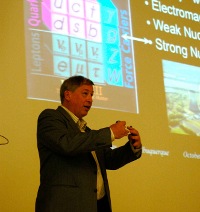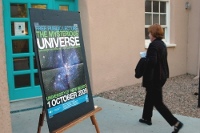 |
 |
|||||||||||||
|
|||||||||||||
|
|||||||||||||
Even though University of Oregon professor and Americas regional contact for the ILC physics and detectors studies Jim Brau had specifically invited a young audience to his public lecture on 1 October in the University of Albuquerque, he thought of teenagers and university students rather than seven–year–olds. But Brau gave particle physics one of its youngest fans — little Abigail Zwartz was so gripped by his talk that she took notes eagerly and even presented them in school the next day. Jim Brau's talk was among the first public lectures organised during a linear collider workshop; the ALCPG 09, to be precise. Called “The mysterious Universe — exploring our world with particle accelerators,” it was an hour–long adventure into the world not only of particle physics but everything around it as well: Galileo, Newton, Einstein, cosmology, space and time, particles, forces, antimatter, dark matter and dark energy. Of course it focused on the next big project in the field: the Large Hadron Collider LHC, due to start up again this month, and the ILC as the possible next adventure in the less immediate future. Held in a lecture hall of the anthropology section of the University of New Mexico, it drew a crowd of just over 100 people — many university students, members of the local astronomy club, physics teachers and of course little Abigail with her parents. (Her mother Sally Seidel, a particle physicist herself and organiser of the workshop, hosted the lecture.) Bold posters had announced the lecture on campus for several days — or at least they were supposed to do so; they proved so popular among students that most of them disappeared from announcement boards overnight. As it proved so popular it is unlikely to be the last public lecture organised around a linear collider conference. If you would like to volunteer as a speaker, please let the communicators know! As lectures should be given in the local language please tell us which languages you speak (and answer questions about vacuum, particles and black holes) happily. After an hour of explaining basics, combining ideas and experiments, putting theories into context and asking the big questions that drive the field, Jim Brau closed his lecture with an appropriate Einstein quote: “The most beautiful experience we can have is the mysterious. It is the fundamental emotion which stands at the cradle of true art and true science.” -- Barbara Warmbein
|
|||||||||||||
| © International Linear Collider |

